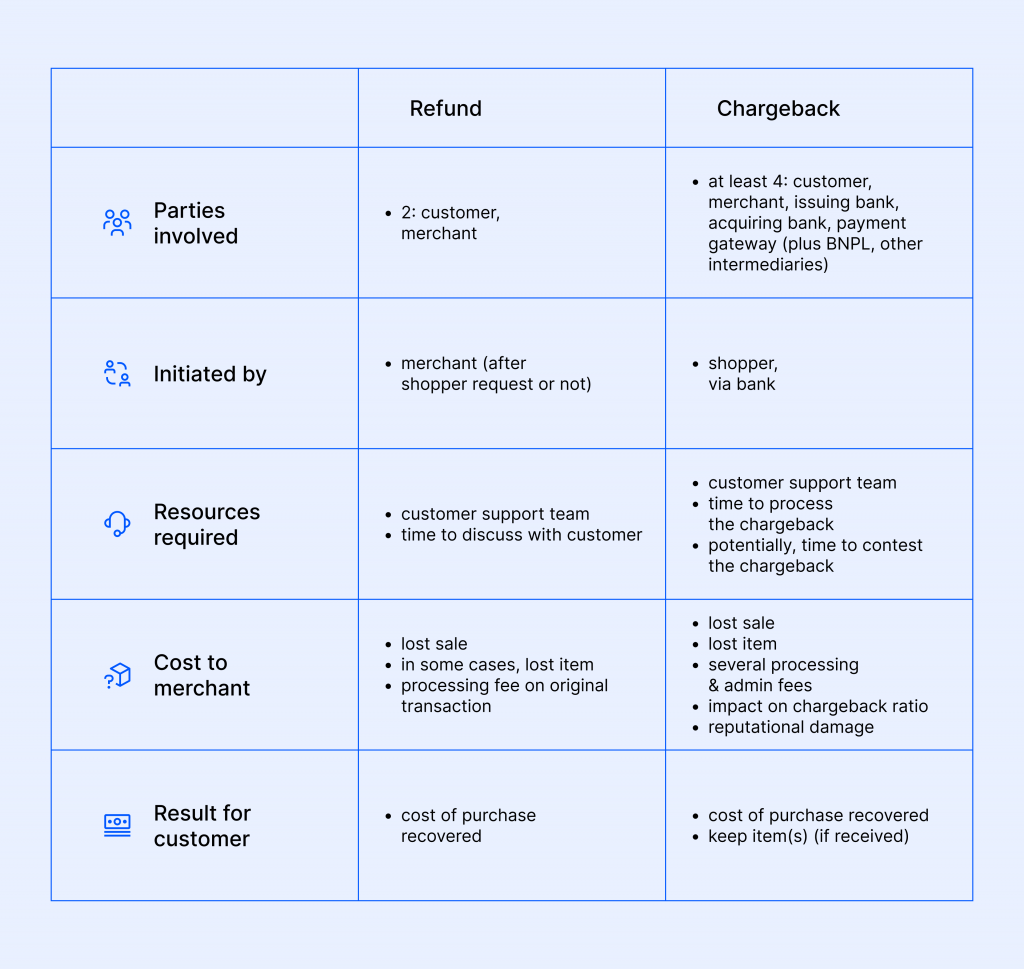Chargeback vs. Refund: Why Difference Matters

Both chargebacks and refunds complete the same purpose from the users’ perspective – returning the money back. However, it is very different for the business and both could be extremely harmful. How users choose the way to restore their funds and how to work around these options we will discuss further.
Table of Contents
Difference Between Chargebacks and Refunds
Refund is a process of reimbursing the money to a customer for a product or service that did not meet their expectations or was unsatisfactory in some way. Usually, businesses have a flexible and adjustable refund policy with the purpose of building a friendly relationship with their clients. However, too many refunds provided could not be beneficial to a business and lead to massive losses:
- Processing costs: a company usually pays transaction fees as well as refund fees to their acquirer to process the transaction. Moreover, if physical goods are involved, there are additional costs as shipping and administrative that could rise to significant numbers;
- Revenue loss: it is understandable that whether a customer was satisfied with the goods/services or not, there were resources spent for providing it, and refunding too many of them would not lead to a revenue boost;
- Customer exploit: if the refund policy is too flexible for the consumers, there is always a threat of refund misuse. Clients might make the most out of the company’s kindness and constantly request refunds even when the service or product is satisfactory.

Chargeback is a more complex procedure involving reaching out to the bank issuer to request the money return by confirming they either do not recognize the transactions, or there was something wrong with the product/service provided.
Considering the fact that Visa and MasterCard have very strict policies and limitations chargeback-wise, businesses are always interested in reducing this metric. The reason for that generally, it says a lot about business if clients are constantly not satisfied with the service and use a chargeback option to retrieve their expenses.
What is a Double Refund
Double refund chargebacks occur when a cardholder reaches out to both the merchant and their card issuer regarding a disputed transaction.
In response, the merchant approves a refund, while the issuer simultaneously triggers a chargeback through the relevant card scheme. This results in a dual financial setback for the merchant, encompassing the refund expenditure and the chargeback, not to mention any associated chargeback fees from their acquirer.
To preempt the occurrence of double refund chargebacks, it is crucial to process refunds promptly and transparently communicate to customers the typical timeframe for refund appearances in their accounts. Taking these steps can dissuade customers from assuming there’s an issue and resorting to initiating a chargeback.
Which Option is Better for Merchants

Both chargebacks and refunds are less than ideal, as they both stem from customer dissatisfaction.
Refunds may be viewed as more favorable for merchants due to their speed and cost-efficiency. Merchants can save valuable time, effort, and expenses that would otherwise be spent on responding to dispute notifications and collecting compelling evidence to contest chargebacks.
Refunds also grant merchants greater control. They can provide customers with alternative solutions, such as vouchers or equivalent products, or impose conditions like time limits or the requirement for customers to return goods for resale. In contrast, chargebacks involve processes, time constraints, and conditions beyond the merchant’s influence.
Typically, cardholders are unlikely to return goods or services after an unsuccessful chargeback, particularly if they haven’t had direct dealings with the merchant. This leaves merchants bearing the brunt of the sale cost, fulfillment expenses, and chargeback fees.
A fair refund process can enhance the long-term value of a customer. Research indicates that satisfying dissatisfied customers can foster greater loyalty to a business than if they had never encountered an issue.
What Leads to Merchants Receiving Chargebacks Rather than Refunds?
Customers resort to their card issuers to address disputed payments for various reasons. Frequently, this occurs when customers cannot identify the transaction on their statement and are uncertain about whom to approach.
To prevent this, businesses can take steps like employing transparent billing descriptors that reflect on customer statements. Additionally, selecting a business name that aligns with what customers are most likely to recognize, even if it differs from the registered or trading name, can be beneficial.
Businesses should also facilitate easy resolution of customer inquiries by providing readily accessible contact information. This could be a customer service phone number or email address included in the ‘city’ field on the cardholder statement.
Another common situation where chargebacks prevail over refunds is when a customer falls victim to fraud, leading to multiple unauthorized transactions appearing on their statement. Instead of reaching out to individual merchants for refunds, they opt for a streamlined resolution through their issuer.
There’s also a phenomenon known as chargeback fraud, wherein a legitimate customer claims not to recognize or have made a card purchase, yet retains the purchased goods or enjoys the service without making payment. This is sometimes referred to as ‘first-party fraud’ or ‘friendly fraud,’ resulting in a chargeback rather than a refund.
Few points for the businesses to implement in order to push Customers for a refund instead of a chargeback:
- Clear refund policy. Before making a purchase shoppers rarely check the refund policy in Terms & Conditions. They tend to believe that if something goes wrong with the order, they always have an option to retrieve their funds. Nevertheless, there are circumstances when a consumer does not have an understanding of who to go to, or which proofs to provide to receive their money back. This is why it is easier to send the claims to the eminent bank and have the issue resolved much faster.
- Support team contact information. Whenever a client has an issue with the product or service provided, access to a live chat and/or a reachable phone number to speak with customer support agents. The main goal is to give a push to the consumer to direct the request to the company itself, not their cardholder bank.
- Billing descriptor. Up to 15% of all disputes occur due to unrecognized transactions from the users’ side in the bank statement. It happens because a company sometimes uses generic descriptors so it might be complicated for the customer to identify the purchase. It is strongly recommended to choose a billing descriptor with the exact business name or the business category to avoid such confusion.
To sum it up, it is obligatory for the business to have stabilized chargeback and refund rates. Both could be reached by building a trusted relationship with their customers by providing high-quality service and products. Yet, at the same time, have a smart policy on managing those who have sent such requests and re-consider providing the service to them again. The perfect balance of great products and fair policies would bring each business a remarkable value and prevent chargeback and refund challenges.
How Can Chargebackhit Help?
When comparing chargebacks to refunds, the choice is clear in terms of which is less detrimental. Issuing a refund is typically faster, simpler, and less expensive than handling a chargeback. However, if chargebacks continue to pose an issue, it might be wise to explore professional assistance.
Chargebackhit provides comprehensive solutions for addressing post-transactional fraud. We can assist you in crafting a tailored chargeback management strategy for your business, allowing you to delegate chargeback management and concentrate on the growth of your business. Feel free to reach out to us today to commence the process.
FAQ: Chargeback Vs. Refund
What’s the Difference Between a Chargeback and a Refund?
Chargebacks and refunds are two distinct processes for handling payment disputes.
Chargeback: Initiated by the customer through their bank, a chargeback investigates unauthorized or unsatisfactory transactions. If valid, the bank reverses the charge.
Refund: A refund is issued by the seller to return the purchase amount to dissatisfied customers.
How Do the Processes and Responsibilities for Chargebacks and Refunds Differ?
Chargebacks and refunds differ significantly in how they work:
Chargebacks: Customers initiate chargebacks, involving their bank. Merchants may incur fees and lose funds if the chargeback is valid.
Refunds: Merchants initiate refunds directly, without bank involvement. There are generally no fees, and merchants have more control over the process.
What Are the Implications for Merchants When Handling Chargebacks and Refunds?
Merchants need to consider various factors:
Chargebacks: Risk of fees and loss of funds, potential harm to reputation, meticulous record-keeping, and a more complex process.
Refunds: Lower costs, greater control, the opportunity to maintain customer relations, and potential for improving profitability through rate monitoring.
 PayPal
PayPal Blog
Blog


